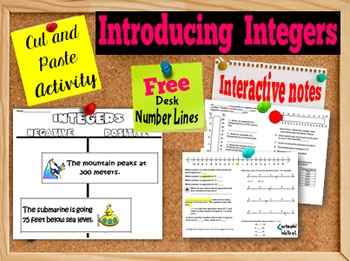Introduction to Integers: Interactive Notes and Activity
Suzie's Angle
218 Followers
Resource Type
Standards
CCSS6.NS.C.5
CCSS6.NS.C.6a
CCSS7.NS.A.1
Formats Included
- Word Document File
Pages
10 pages
Suzie's Angle
218 Followers
Description
This is a set of interactive notes that include: definition of integer, real-world examples of integers on vertical and horizontal number line, ordering integers, opposites, absolute value, comparing absolute value, and writing integers of given a situation.
It also includes a cut and paste activity on writing integers of a given situation. Students sort/classify situations as examples of a positive or negative numbers and paste answers in a T-chart. For example, The elevator went down 4 floors would be an example of a negative number. There are two sets of 12 cards to sort. Each set comes in a large version ( for 8.5 x 11" T-chart) and a small version (for interactive notebook size T-chart). The T-chart is in the set too. Just Print and Go!
I've made word art from the vocabulary in the notes that students can color for a word wall, bulletin board, or anchor chart. I'm also including a FREE set of student desk number lines. These are one of my most useful things I have made!
Introduction to Integers: Interactive Notes and Activity by Suzie's Angle is licensed under a Creative Commons Attribution-NonCommercial-NoDerivatives 4.0 International License.
It also includes a cut and paste activity on writing integers of a given situation. Students sort/classify situations as examples of a positive or negative numbers and paste answers in a T-chart. For example, The elevator went down 4 floors would be an example of a negative number. There are two sets of 12 cards to sort. Each set comes in a large version ( for 8.5 x 11" T-chart) and a small version (for interactive notebook size T-chart). The T-chart is in the set too. Just Print and Go!
I've made word art from the vocabulary in the notes that students can color for a word wall, bulletin board, or anchor chart. I'm also including a FREE set of student desk number lines. These are one of my most useful things I have made!
Introduction to Integers: Interactive Notes and Activity by Suzie's Angle is licensed under a Creative Commons Attribution-NonCommercial-NoDerivatives 4.0 International License.
Total Pages
10 pages
Answer Key
N/A
Teaching Duration
2 days
Report this resource to TPT
Reported resources will be reviewed by our team. Report this resource to let us know if this resource violates TPT’s content guidelines.
Standards
to see state-specific standards (only available in the US).
CCSS6.NS.C.5
Understand that positive and negative numbers are used together to describe quantities having opposite directions or values (e.g., temperature above/below zero, elevation above/below sea level, credits/debits, positive/negative electric charge); use positive and negative numbers to represent quantities in real-world contexts, explaining the meaning of 0 in each situation.
CCSS6.NS.C.6a
Recognize opposite signs of numbers as indicating locations on opposite sides of 0 on the number line; recognize that the opposite of the opposite of a number is the number itself, e.g., -(-3) = 3, and that 0 is its own opposite.
CCSS7.NS.A.1
Apply and extend previous understandings of addition and subtraction to add and subtract rational numbers; represent addition and subtraction on a horizontal or vertical number line diagram.





